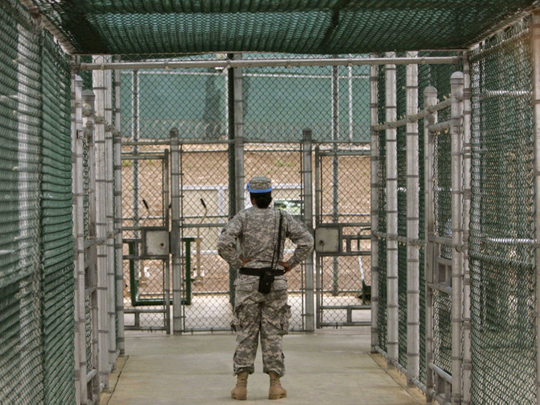
Twenty years ago this month, the military transformed the US naval base in Guantnamo Bay, Cuba, into a detention camp for suspected terrorists. The first arrivals, largely captured in Afghanistan, were shackled, dressed in bright orange jumpsuits and photographed cowering behind barbed wire.
The US government claimed it could hold these “enemy combatants” indefinitely without trial, outside the Geneva Conventions protecting prisoners of war. In response, American attorneys launched numerous lawsuits over habeas corpus, human rights and due process.
But long before the United States held detainees on the base, Cuban workers recognised the base’s strained relationship with the law. Indeed, the base’s legal history is rooted in Cuban history. Cuban workers repeatedly petitioned the US government to recognise their rights on the base.
It was only after the United States stopped depending on Cuban workers that it could reimagine the base as a refugee camp in the 1990s, and then a detention centre in the fight against terrorism. Yet, many of the problems with its use as a detention center echoed the problems exposed by Cuban workers. And these problems remain today.
Spanish-American War
The history of the base goes back to the Spanish-American War in 1898.
US troops fought Spain for a brief six weeks, although Cubans had been fighting for independence for three decades. Spain surrendered to the United States, and the US military remained on the island, refusing to leave unless Cuban leaders accepted the US-written Platt Amendment in their constitution. The amendment greatly limited Cuba’s sovereignty, and it required Cuba to lease land to the United States for a coaling or naval station.
Cuban leaders balked; this was an affront to their years-long campaign for independence. Ultimately, however, they had little choice but to grudgingly vote to accept the Platt Amendment in return for the end of US occupation.
The 1903 Lease Agreement gave Cuba “ultimate sovereignty” and the United States “complete jurisdiction and control” over the 45 square miles that would become the US naval base in Guantnamo Bay. This set up a clear legal contradiction.
With the Great Depression and the military build-up before World War II, thousands of Cubans sought jobs on the base. The base offered better salaries and more steady work than jobs on sugar plantations. Many Cubans valued these base jobs, but working for the US military raised legal questions.
The issue came to a head in 1954. As with most military installations, there was an ongoing problem with petty theft. US officials accused Cuban workers of pilfering everything from bicycles to penicillin. But local Cuban courts, which had jurisdiction, did not often prosecute or convict these offences.
US-Cuban relations
The local courts did not prioritise these cases, and they often even refused to return stolen goods to the United States. Base officers began to investigate whether they could try Cuban workers themselves. This created a conflict between military officials who wanted to crack down on theft and State Department officials who valued amicable US-Cuban relations more than a missing radio or $100.
This changed with the 1959 Cuban Revolution, and the subsequent rupture of US-Cuban relations. The base did not stop the revolution. Many Cuban workers initially thought they could support the revolution and continue working on the base. But by 1964, the US government wanted the base to be more self-sufficient.
It fired the majority of Cuban workers and then brought in Jamaican and Filipino contract workers. This trend accelerated during the 21st-century wars in the Middle East. With this, the US base in Guantnamo Bay became more and more of an island unto itself.
The United States would double-down on its power to hold people on the base in the 1990s when it transformed the base into a Haitian refugee camp. The United States argued that Haitians on the base were not governed by the US. Constitution.
Abused or detained indefinitely
By this point, there were no worker protests. However, human rights lawyers fought for Haitians’ due process rights in language that would have been familiar to Cuban base workers, emphasising that people held on the base must have access to lawyers and can’t be abused or detained indefinitely.
What these stories reveal is that in some ways, the military prison at Guantnamo Bay had a precedent — the United States historically did not recognise that a clear legal standard applied to non-Americans on the base.
Before the revolution, it was only Cuban workers who spoke out, and the Eisenhower administration’s desire to maintain good relations, that checked the US military’s ability to detain them. Cuban workers recognised that the base’s tenuous legal framework opened the door for injustice, arbitrariness and even allegations of torture.
The handling of detainees in the fight against terrorism brought these dangers to fruition. The Cuban workers’ 1950s protests against detention and allegations of abuse were shockingly prescient. The main reason the United States chose to create a prison camp in Guantnamo Bay was because it could simultaneously hold the detainees outside the United States and not be constrained by a host country.
So long as this remains true, there is a risk of the United States using the base to hold others.
Jana Lipman is associate professor at Tulane University and author of “Guantnamo: A Working-Class History between Empire and Revolution.” She is currently writing a book on refugee camps after the Vietnam War.
Washington Post











